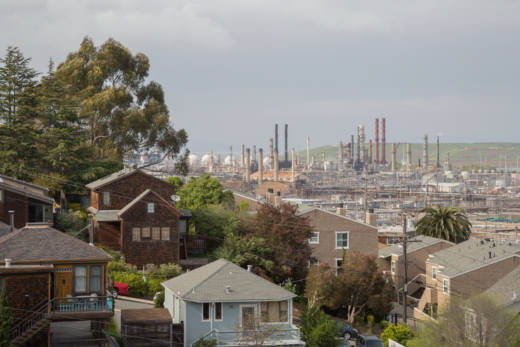The chances that a problem at a refinery on one side of the bay could send toxic gas to another depends in part on which way the wind blows.
"If the wind direction is not blowing the air towards you, you're not going to smell it," said Anthony Wexler, director of the Air Quality Research Center at UC Davis.
The winds the night of the Chevron malfunction were blowing between 5 and 10 mph from the north-northeast to the south-southwest, according to Jan Null, a meteorologist with Golden Gate Weather Services.
There are other weather facts at play, according to Wexler. If plumes of smoke and gas that erupt during refinery flaring don't mix well enough into the atmosphere, they can travel and affect a larger area, he said.
The Chevron case involved hydrogen sulfide, which smells like rotten eggs.
"Given that Chevron's own monitors apparently measured a high concentration of hydrogen sulfide shortly before people smelled an odor in San Francisco, and winds can blow a rotten smell 10 miles in 10-20 minutes, I strongly suspect the San Francisco odor was caused by Chevron's refinery," said Mark Jacobson, a professor of civil and environmental engineering at Stanford University and director of the school's Atmosphere and Energy Program.
Some residents of Richmond, Rodeo, Benicia and Martinez—cities where local refineries are located—have complained for years about unhealthy air coming from their oil industry neighbors.
But residents in large parts of the rest of the region might not feel a refinery can affect them.
"Unfortunately, the source at Chevron has had issues like this before. The difference here is that it affected a wider area, including San Francisco," said John Gioia, a Contra Costa County supervisor and member of the Bay Area Air Quality Management District's board of directors.
"We've been used to some of these odor issues in Richmond," Gioia said.
The Center of Biological Diversity's Sullivan says the Chevron incident means there's a bigger risk to a larger part of the Bay Area.
"We've always viewed these refineries as a serious hazard to the people who live around them, often those are low-income people, people of color who seem to bear the brunt of this sort of pollution," Sullivan said.
Chevron questions the air district's findings, in part because its refinery is so far away from San Francisco.
"This is a complex issue, but given the small amount of H2S (hydrogen sulfide) released, the 11-mile distance across the bay, and the wide geography of the odor complaints, we believe it is unlikely that the flaring was the source of the odors," said Chevron spokeswoman Leah Casey.
The distance made it tougher for local air regulators to identify the source.
"This was really a complicated issue, because it did span quite a distance and affect a big part of the Bay Area," said Tom Flannigan, an air district spokesman.
"When such a large area is affected, we really have to look closely at all the sources that could have caused it," Flannigan said in an interview. "In this case, that meant more time, that meant more energy, that meant more analysis. That meant more data review."
San Francisco officials will now tackle the issue. Now that the air district investigation is complete, a Board of Supervisors committee is expected to hold a hearing on the refinery malfunction in the coming weeks.
"Chevron must be held accountable for the toxic gas that lingered in the air," said Supervisor Mark Farrell, who called for the hearing. "Reforms must be implemented immediately to ensure this never happens again."
